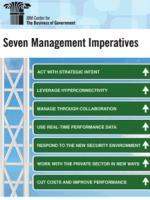
Seven Management Imperatives: Imperative Four - Use Real-Time Performance Data

In the coming years, government executives will need to utilize real-time information for decision-making and accountability. Specifically, they must (1) Collect better data; (2) Conduct better analysis; (3) Make better decisions; and (4) Take smarter action.
Harry Hatry, a pioneer in the performance measurement field, recently predicted that “performance data in the future will be able to be processed continuously and in real time,” and that “managers and their staffs will be able to obtain such information easily and quickly, no matter where the managers are. The information will come from a variety of mobile sources.”
The imperative for government executives over the next several years will be to take action to realize Hatry’s vision and respond to the new demands of political leaders and the public for information that can be used for decision-making and accountability. This imperative will challenge leaders and managers to take action to:
- Collect better data
- Conduct better analysis
- Make better decisions
- Take smarter action
Action One: Collect Better Data
The first action leaders and managers will need to take to create a real-time performance data environment is to increase data’s availability and reliability.
Agency leaders will need to prioritize their data collection and sharing by linking them to clearly defined outcome goals and identify what performance information is needed to track progress against them. There will also be a need for leaders and managers to allow easy feedback, via social media tools, from employees and—where appropriate—the public. This creates an early warning system to alert program managers about possible performance and data reliability problems.
The best example of a cross-agency, data-intensive web portal that includes interpretive tools is Recovery.gov, which tracks spending and performance under the American
Reinvestment and Recovery Act of 2009 (Recovery Act). It provides basic performance information about the uses of Recovery Act money. The portal is updated quarterly and displays information in different ways for different audiences. For example, citizens can enter their zip codes and see a geographic display of projects (including the amount of money spent on each project) in their neighborhoods.
State governments are increasingly providing real-time data as well. For example, the states of Alaska, Arkansas, and Colorado all have an “open checkbook” policy, whereby all checks written by the treasurer go online so citizens can follow expenditures. Many municipalities provide real-time, online traffic video, snowplow tracking, and citizen tracking of 311 open service requests for potholes, graffiti, and burnt-out street lights.
Action Two: Conduct Better Analysis
The flood of new data calls for increased use of new analytic tools by both decisionmakers and the public. This means leaders and managers will have to understand who their users are and what kinds of data and data displays will provide meaning for them. Better analysis starts with clear goals and priorities that are linked to progress measurements. For example, the Obama administration has worked with agencies to identify a
small number of priority performance goals. These goals have become the focus of increased analysis. In this new environment, as Shelly Metzenbaum notes in her 2009 report for the IBM Center, agencies should be expected to conduct analyses:
- To know the direction of performance trends for key indicators
- To understand the causes for performance change or have a plan to discover the causes
- To search for performance-improving opportunities to promote and performance-dampening conditions to prevent In today’s environment, agencies should expect questions and be prepared to answer them.
Action Three: Make Better Decisions
The third action will be to use the new data and analyses effectively to make choices and set priorities. Hatry says, “The challenge today is no longer in collecting information; the challenge now lies in using the information that is regularly collected.” Program effectiveness can be improved by taking timely corrective action based on information collected.
In his 2007 report to the IBM Center, Robert Behn emphasizes that performance-stat systems should be viewed as a leadership strategy designed to produce clearly specified results. The common feature of all the performance-stat systems he examined: the organization’s leader meets with his or her management team to focus attention and assess progress toward the organization’s goals.
Action Four: Take Smarter Action
The fourth action is to create a real-time performance data environment that ensures the ability to use data to take smarter action. This means that real-time data should not be collected and used solely to react to past events. Using smart sensors and interconnected data sets will allow more sophisticated analyses of data that are predictive in nature. This means leaders and managers can foresee and forestall potentially adverse performance.
This predictive approach would not only be based on better data that links plans, targets, day-to-day operations, and resources, but would also include improved risk analysis.
Real-time performance data are already in use. For example, they are being used to predict flooding in vulnerable communities so that populations can be relocated in advance; to forestall air traffic delays due to congestion; to improve food safety initiatives, and to rapidly determine eligibility for Social Security or veteran’s disability benefits.
Sometimes better action comes from a shared understanding of mission. Agency leaders and managers should therefore develop strategies to effectively communicate trends and targets. These are the basis for leaders and managers to understand and address trends in performance



